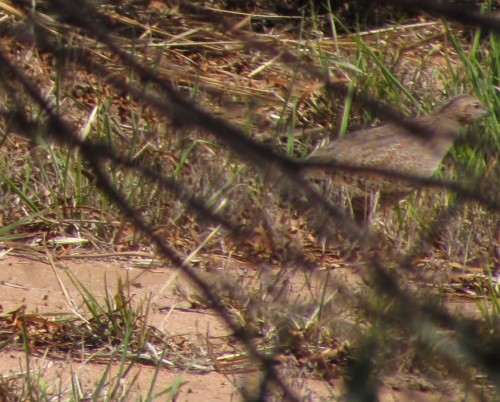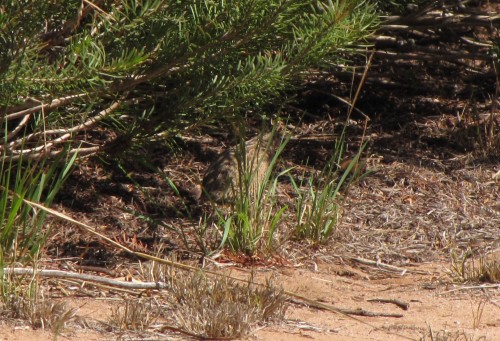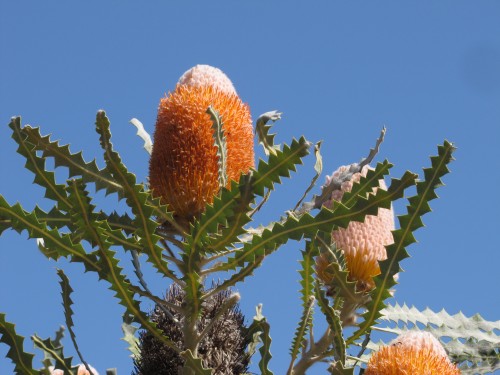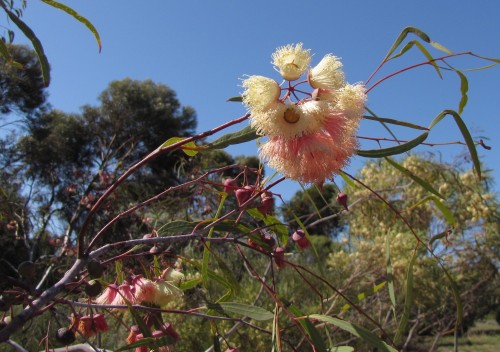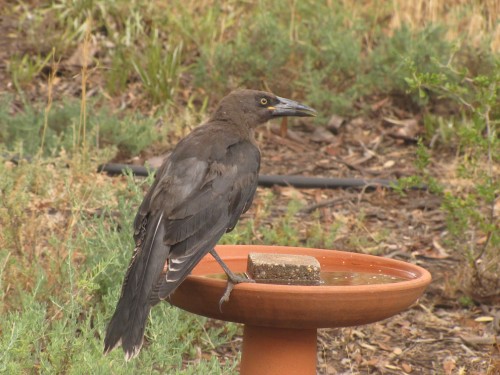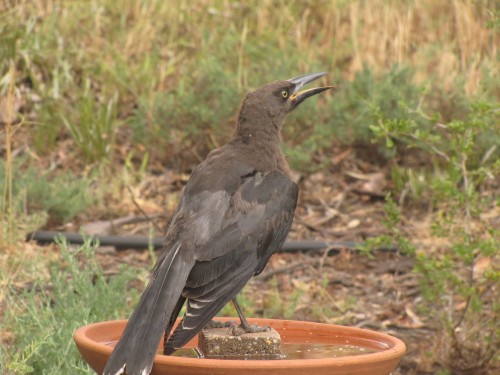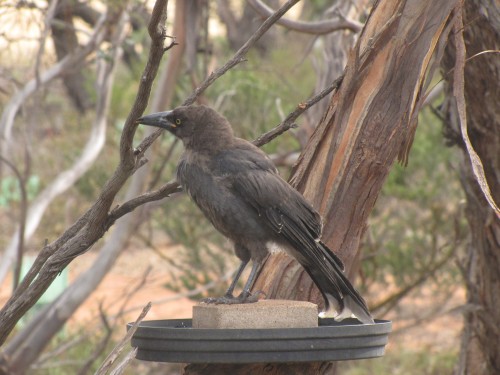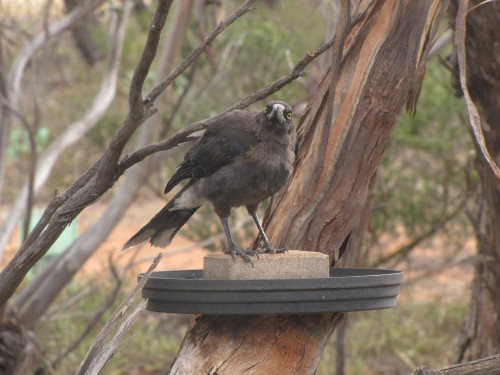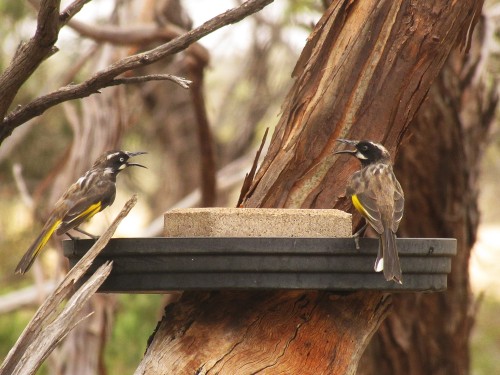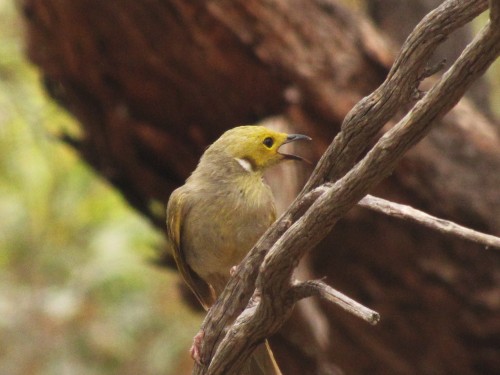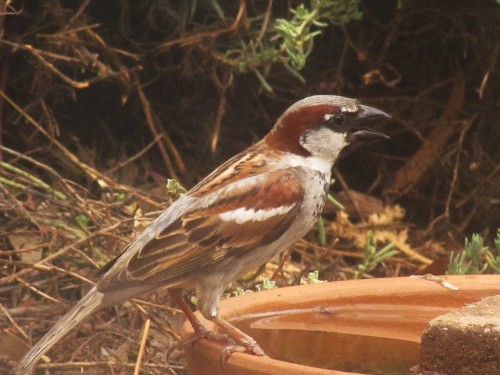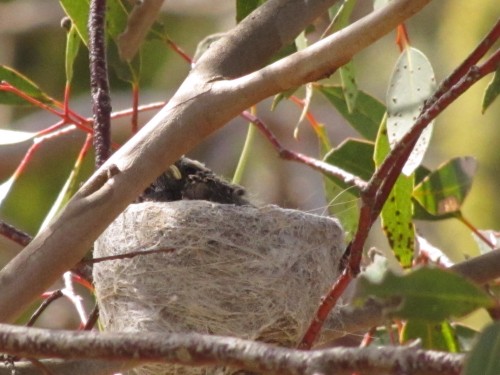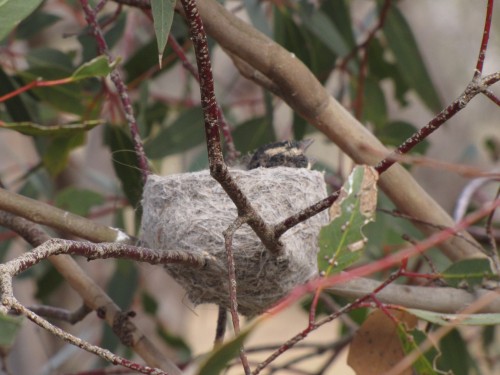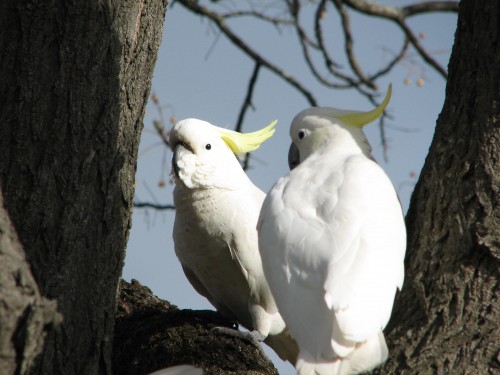Calling up a Brown Quail
Yesterday was my wife’s birthday.
To celebrate we went out to lunch with friends, and then drove south to Wellington on the River Murray. After crossing the river on the ferry we drove the short distance to the Pangarinda Botanic Gardens (formerly known as the Pangarinda Arboretum). My wife enjoys exploring places where native Australian plants are the feature. You can check out her site about Australian plants here.
We found a shady spot in the middle of the gardens, complete with a table and seats. The garden all around us was alive with birds, especially dozens of New Holland Honeyeaters. We also saw White-browed Babblers, Red Wattlebirds and Little Wattlebirds, along with dozens of Tree Martins soaring on the breeze hawking for insects (photos to come in a few days’ time).
As we were having a cuppa and some delicious birthday cake, we heard an interesting call nearby. It wasn’t long before we spotted a quail-like bird skulking through the garden about 50 metres away. I checked my bird app on my phone and immediately recognised the call of the Brown Quail. I knew that I didn’t have a photo of this species, so I set off in pursuit. I actually managed only two photos which I have cropped and shown here today. They are not brilliant photos, but they are the best I have.
This is the first time I have seen this species, even though they are relatively widespread in the region where I live. They can be quite shy birds, hiding in grasses and bushy areas. I guess that they have found these gardens to their liking and are getting used to people being around quite often. I was amused when my friend Keith started imitating the call – and both birds answered him from nearby. They also answered the call from the app on my phone. Neither Keith’s call, nor that from my phone made them come closer to investigate. At one point one of them did fly low over the table where we were sitting, but it went straight into a bushy area and out of sight.
As far as I can tell from my memory and records, this sighting is a “lifer“, that is, it is the first time in my life I have seen this species.
Further reading (click on the title):
- Mallee Native Plants – my wife’s site about Australian plants
- Pangarinda Arboretum – some flower photos are featured in this post
- Birds and plants of Pangarinda Arboretum – more photos of the beautiful plants in these gardens
- Spotted Nightjar at Pangarinda
- Red-capped Robin at Pangarinda – featuring possibly my favourite photos of any bird
Below I have included several flower photos taken yesterday.
Hot weather birding
Over recent posts I have written about the very hot conditions we have had here in South Australia this summer. I won’t bore you by stating the obvious yet again. When the weather gets much over 30C (86F) I tend not to go out birding, though I have on occasions been out in much hotter weather.
When the temperature soars here in Murray Bridge (80 km SE of Adelaide) I tend to stay indoors as much as possible. It is one of the joys of being ‘retired’. On these occasions we have the delight of a constant stream of birds coming to our bird baths. These containers are strategically placed in our garden where we can observe – and photograph – the birds at our leisure. On very hot days like we have had over recent months the stream has sometimes been a flood.
When the Grey Currawongs come to drink, most of the smaller birds keep their distance. I am not surprised by this; the Currawong’s bill and head is about the size of birds like the thornbills or the wrens. I guess that the smaller species know instinctively that the Currawong is capable of raiding their nests for eggs and baby birds, and so they remain at a respectful distance while the bigger birds are drinking.
During one of our recent hot spells this juvenile Grey Currawong came for a drink. I can tell that it is a young one not long out of the nest because of the downy feathers, as well as the yellow gap on the bill. Only a few days before these photos were taken I saw the juveniles being fed by the adults.
Once the Currawong had finished drinking, the smaller birds quickly returned.
Birds in the heat
Here in South Australia we are experiencing our hottest summer on record. I won’t bore you with the details, but just say that we have had far too many days in the 40s (45C is equal to 113F). During such heatwaves – which can last for several days – our bird population suffers terribly. On these days the resident birds in our garden really appreciate the various bird baths we have placed in suitable locations.
Even on a warm day we get a constant parade of birds visiting the various bird baths in our garden. Our sun room overlooks several of them and this affords me an ideal location to take photos of them. Some birds still visit the water even on quite cold days – but we haven’t had many of those lately.
Probably the most common visitors would have to be the honeyeater species, including:
- Red Wattlebirds,
- White-plumed honeyeaters,
- New Holland Honeyeaters,
- Brown-headed Honeyeaters
- Singing Honeyeaters
- Spiny-cheeked Honeyeaters
Other regular visitors include:
- Australian Magpies
- White-winged Choughs
- Grey Currawong
- Australian Magpie Larks
- Crested Pigeons
- Spotted Turtledove
- Striated Pardalote
- Spotted Pardalote
- Silvereyes
- House Sparrow
- Common Starling
- Common Blackbird
Baby birds everywhere
Over the past month or so the area around our garden has been full of birds nesting, sitting on eggs, feeding young or busy feeding the fledglings after they leave their nest. Spring time here in South Australia is the main breeding season for many species of birds, especially the bush birds. Many of our trees and shrubs are also flowering which means plenty of food for the birds, both the nectivorous and insectivorous species.
Here is an annotated list of the species I have observed nesting or feeding young this spring, plus a few species I suspect have been nesting nearby. All of these observations have been in our garden or on our 5 acre property in Murray Bridge, South Australia.
- Willie Wagtail – the photos of the nest (above and below) on today’s post are of the nest with two babies just peeping over the top of the beautiful cobweb lined nest. They have since fledged and are flying around begging for food.
- Australian Magpie – I knew that our resident magpies were nesting but it was only when the young started calling to be fed that I found the nest. They had made a nest in a completely new tree this year. Last year’s nest tree was blown over by one of our winter storms. (Must cut it up for firewood.)
- House Sparrow – these seem to be always nesting, not just in the spring.
- Common Starling – about a dozen tree hollows had nests in them and it is quite obvious when there are babies in the nest; their calling for food is incessant. Most of the starlings have now flown off to the fruit growing districts nearby.
- Red Wattlebird – there have been several fledged young wattlebirds getting around in recent weeks. I suspect that the adults may well be nesting again. The male continues to boss all the other smaller species quite unmercifully. They don’t like sharing their food, even though there is plenty to go around.
- New Holland Honeyeater – I saw several parents feeding young just out of the nest quite a few weeks ago. They may well be nesting again, but their nests are usually well hidden in dense bushes.
- Peaceful Dove – we saw a pair mating and they have been hanging around close to the house for many weeks. I have yet to find the nest – in part due to a very bad back at present.
- Crested Pigeon – this species always seems to be breeding, but they chose a bush quite a distance from the house this spring.
- Spotted Turtledove – again, due to my back I haven’t yet found their nest.
- Galahs – this one is tragic. After many attempts at breeding over several years in a tree hollow near the house they finally hatched a brood of young, only to see them die in the nest during an unseasonably hot spell several weeks ago.
- Common Blackbird – this species often makes a nest in our garden shed, but this year they seem to be nesting next door and only visit our garden occasionally.
- Australian Magpie-Lark – again, this species has chosen to nest in the neighbour’s tall trees. They visit our garden frequently to catch food for the young.
- White-winged Chough – another species which visits frequently – except in recent weeks. I often see them down the road about a hundred metres away, so they are probably nesting there.
- Little Ravens – although several of this species visit almost daily, I have yet to record them nesting in one of our trees, preferring to keep away from the magpies’ nest, I presume.
- White-browed Babblers – it has been quite a few years since they last nested in our garden but they are regular visitors – except in recent weeks – they must be nesting somewhere nearby.
- Superb Fairy-wren – our resident pair still seems to be around the house garden, but they are very quiet and secretive about the location of their nest.
- Cuckoos – we have heard the calls of the Horsfield’s Bronze-cuckoo a few times several weeks ago but have seen no evidence that they stayed long enough to nest.
- Other possibilities: White-plumed honeyeater, Singing Honeyeater, Spiny-cheeked Honeyeater, Yellow-rumped Thornbill, Weebill, Striated Pardalote, Spotted Pardalote.
Some unexpected visitors
This morning I did a small load of washing. I actually enjoy doing this because it gets me outside and away from the computer for a while. It also has the benefit of getting me outside where the birds are, and with my eyes cast skywards I often see birds that I might have missed – like the time I saw a Peregrine Falcon overhead in the last moments of a very fast stoop. Awesome.
It also has the benefit of being able to hear more birds and I enjoy listening to all of their calls and trying to identify them without looking. This is a good way of honing one’s identifiction skills. After over 30 years of living on our little patch of mallee scrub here in Murray Bridge, I have become accustomed to our bird life and immediately notice something different calling. That’s what happened this morning.
I had just finished hanging out the washing when I heard a bird calling loudly. Two Sulphur-crested Cockatoos had flown in and landed in our of our pine trees. I had enough time to grab the binoculars and see that they were testing out some of the cones on one of the trees. Obviously the cones where not to their taste or not ready for eating because they flew off again a minute later. I didn’t get a photo so the one above was taken some years ago in Adelaide.
This was a significant sighting for the birds in our garden. I think my memory is correct – this is only the second time in over 30 years I have recorded this species in our garden. They are not usually seen here in Murray Bridge (80km east of Adelaide) though they are very common in the Adelaide region and throughout the Adelaide Hills zone. This is despite there being plenty of suitable feeding spots and nesting hollows, especially along the River Murray. I think I heard one screeching as it flew overhead a few days ago, but I was in the foggy early morning sleep zone. I initially thought it was a Little Corella, but now I am not so sure.
Perhaps these were some scouts looking for new places to live.
